MaryAnn Bernal's Blog, page 242
September 4, 2014
Facebook Event - Alex the Mutt From "Death Row to Cozy Home - August 19 - September 19 2014
Alex the Mutt From "Death Row to Cozy Home.

Aug 19 at 12:00am to Sep 19 at 3:00am in PDT
This is a subject that is dear to my heart. There are too many precious animals that are on the streets or in kill shelters who need homes. Sometimes just spreading the word makes a big difference. Facebook Link Alex the Mutt is up for Pre-order on Amazon


Aug 19 at 12:00am to Sep 19 at 3:00am in PDT
This is a subject that is dear to my heart. There are too many precious animals that are on the streets or in kill shelters who need homes. Sometimes just spreading the word makes a big difference. Facebook Link Alex the Mutt is up for Pre-order on Amazon

Published on September 04, 2014 05:18
Facebook Event - Alex the Mutt From "Death Row to Cozy Home - August 19 - Septembeer 19 2014
Alex the Mutt From "Death Row to Cozy Home.

Aug 19 at 12:00am to Sep 19 at 3:00am in PDT
This is a subject that is dear to my heart. There are too many precious animals that are on the streets or in kill shelters who need homes. Sometimes just spreading the word makes a big difference. Facebook Link Alex the Mutt is up for Pre-order on Amazon


Aug 19 at 12:00am to Sep 19 at 3:00am in PDT
This is a subject that is dear to my heart. There are too many precious animals that are on the streets or in kill shelters who need homes. Sometimes just spreading the word makes a big difference. Facebook Link Alex the Mutt is up for Pre-order on Amazon

Published on September 04, 2014 05:18
History Trivia - Romulus Augustus, last emperor of the Western Roman Empire, deposed
Sept 4
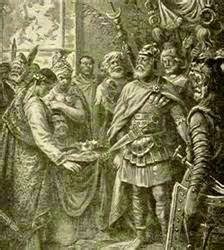
476 Romulus Augustus, last emperor of the Western Roman Empire, was deposed when the barbarian Odoacer proclaimed himself King of Italy, and ended the Western Roman Empire.
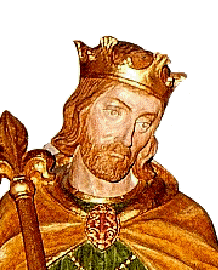
925 Athelstan, grandson of Alfred the Great, was crowned King of England. First elected king of Wessex and Mercia, Athelstan was crowned king of the entire country at Kingston.

1241 Alexander III of Scotland was born. The reign of Alexander was considered a golden age by Scots involved in struggles with England after his death.


476 Romulus Augustus, last emperor of the Western Roman Empire, was deposed when the barbarian Odoacer proclaimed himself King of Italy, and ended the Western Roman Empire.

925 Athelstan, grandson of Alfred the Great, was crowned King of England. First elected king of Wessex and Mercia, Athelstan was crowned king of the entire country at Kingston.

1241 Alexander III of Scotland was born. The reign of Alexander was considered a golden age by Scots involved in struggles with England after his death.

Published on September 04, 2014 05:15
September 3, 2014
Diane Turner - London Rocks - 02.09.2014
Published on September 03, 2014 05:37
History Trivia - Richard I of England (the Lionhearted) is crowned King at Westminster
Sept 3

1189 Richard I of England (the Lionhearted) was crowned King at Westminster.
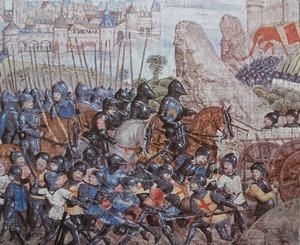
1346 Edward III of England began the siege of Calais, along the coast of France.
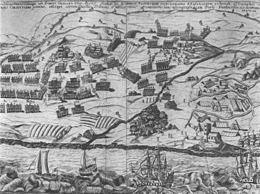
1650 Third English Civil War: in the Battle of Dunbar, English Parliamentarian forces lead by Oliver Cromwell defeated an army loyal to King Charles II of England and lead by David Leslie, Lord Newark.
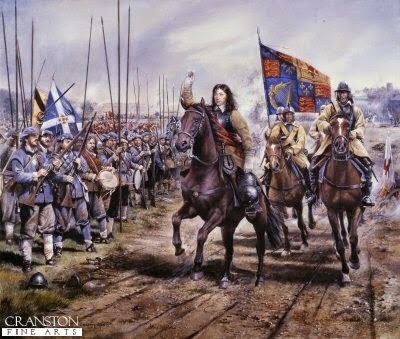
1651 Third English Civil War: Battle of Worcester – Charles II of England was defeated in the last main battle of the war.


1189 Richard I of England (the Lionhearted) was crowned King at Westminster.

1346 Edward III of England began the siege of Calais, along the coast of France.

1650 Third English Civil War: in the Battle of Dunbar, English Parliamentarian forces lead by Oliver Cromwell defeated an army loyal to King Charles II of England and lead by David Leslie, Lord Newark.

1651 Third English Civil War: Battle of Worcester – Charles II of England was defeated in the last main battle of the war.

Published on September 03, 2014 04:30
September 2, 2014
Cave Carving May Be 1st Known Example of Neanderthal Rock Art
By Megan Gannon
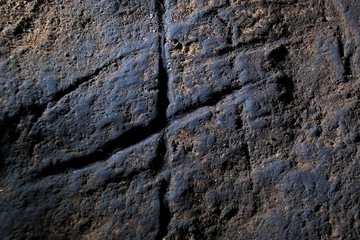
 This abstract cave carving is possibly the first known example of Neanderthal rock art. The etching covers an area of about 47 square inches (300 square centimeters).
This abstract cave carving is possibly the first known example of Neanderthal rock art. The etching covers an area of about 47 square inches (300 square centimeters).
Credit: Stewart Finlayson
Around 39,000 years ago, a Neanderthal huddled in the back of a seaside cave at Gibraltar, safe from the hyenas, lions and leopards that might have prowled outside. Under the flickering light of a campfire, he or she used a stone tool to carefully etch what looks like a grid or a hashtag onto a natural platform of bedrock.
Archaeologists discovered this enigmatic carving during an excavation of Gorham's Cave two years ago. They had found Neanderthal cut marks on bones and tools before, but they had never seen anything like this. The researchers used Neanderthal tools to test how this geometric design was made — and to rule out the possibility the "artwork" wasn't just the byproduct of butchery. They found that recreating the grid was painstaking work.
"This was intentional — this was not somebody doodling or scratching on the surface," said study researcher Clive Finlayson, director of the Gibraltar Museum. But the discovery poses much more elusive questions: Did this engraving hold any symbolic meaning? Can it be considered art?
Close cousins
Neanderthals roamed Eurasia from around 200,000 to 30,000 years ago, when they mysteriously went extinct. They were the closest known relatives of modern humans, and recent research has suggested that Neanderthals might have behaved more like Homo sapiens than previously thought: They buried their dead, they used pigments and feathers to decorate their bodies, and they may have even organized their caves.
Despite a growing body of evidence suggesting Neanderthals may have been cognitively similar to modern humans, a lack of art seemed to be the "the last bastion" for the argument that Neanderthals were much different from us, Finlayson said.
"Art is something else — it's an indication of abstract thinking," Finlayson told Live Science.
Archaeologists recently pushed back the date of hand stencil paintings found at El Castillo cave in northern Spain to 40,800 years ago, which opens the possibility that Neanderthals created this artwork. But there is no solid archaeological evidence to link Neanderthals to the paintings. [See Photos of the Ancient El Castillo Cave Art]
Gorham's Cave
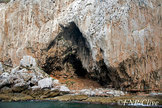
[image error] Gorham's Cave may be the last known site of Neanderthal occupation before these hominids went extinct. In 2006, a carbon-dating study of charcoal from hearths inside the cave suggested that Neanderthals might have survived there until 28,000 years ago.
Gorham's Cave may be the last known site of Neanderthal occupation before these hominids went extinct. In 2006, a carbon-dating study of charcoal from hearths inside the cave suggested that Neanderthals might have survived there until 28,000 years ago.
Credit: Clive Finlayson
View full size imageIn Gorham's Cave, Finlayson and colleagues were surprised to find a series of deeply incised parallel and crisscrossing lines when they wiped away the dirt covering a bedrock surface. The rock had been sealed under a layer of soil that was littered with Mousterian stone tools (a style long linked to Neanderthals). Radiocarbon dating indicated that this soil layer was between 38,500 and 30,500 years old, suggesting the rock art buried underneath was created sometime before then. [See Photos of Europe's Oldest Rock Art]
Gibraltar is one of the most famous sites of Neanderthal occupation. At Gorham's Cave and its surrounding caverns, archaeologists have found evidence that Neanderthals butchered seals, roasted pigeons and plucked feathers off birds of prey. In other parts of Europe, Neanderthals lived alongside humans — and may have even interbred with them. But 40,000 years ago, the southern Iberian Peninsula was a Neanderthal stronghold. Modern humans had not spread into the area yet, Finlayson said.
To test whether they were actually looking at an intentional design, the researchers decided to try to recreate the grid on smooth rock surfaces in the cave using actual stone tools left behind in a spoil heap by archaeologists who had excavated the site in the 1950s. More than 50 stone-tool incisions were needed to mimic the deepest line of the grid, and between 188 and 317 total strokes were probably needed to create the entire pattern, the researchers found. Their findings were described yesterday (Sept. 1) in the journal Proceedings of the National Academy of Sciences.
Finlayson and his colleagues also tried to cut pork skin with the stone tools, to test whether the lines were merely the incidental marks left behind after the Neanderthals had butchered meat. But they couldn't replicate the engraving.
"You cannot control the groove if you're cutting through meat, no matter how hard you try," Finlayson said. "The lines go all over the place."
A simple grid is no Venus figurine
The Neanderthals' brand of abstract expressionism might not have impressed Homo sapiens art critics of the day.
"It's very basic. It's very simple," said Jean-Jacques Hublin, director of the Department of Human Evolution at the Max Planck Institute for Evolutionary Anthropology in Germany. "It's not a Venus. It's not a bison. It's not a horse."
By the late Stone Age, modern humans who settled in Europe were already dabbling in representational art. At least a dozen different species of animals — including horses, mammoths and cave lions — are depicted in the Chauvet Cave paintings, which are up to 32,000 years old. The anatomically explicit Venus figurine discovered at Hohle Fels Cave in southwestern Germany dates back to 35,000 years ago. Other busty female statuettes — the Venus of Galgenberg and the Venus of Dolní Věstonice — date back to about 30,000 years ago.
"There is a huge difference between making three lines that any 3-year-old kid would be able to make and sculpting a Venus," Hublin, who was not involved in the study, told Live Science.
Hublin said this discovery doesn't close the question of Neanderthals' cognitive skills. Proof that Neanderthals were capable of making a deliberate rock carving isn't evidence that they were regularly making art, he said.
"My own feeling is that if Neanderthals regularly used symbols, and given their longtime occupation throughout large parts of the Old World, we probably would have found clearer evidence by now," said Harold Dibble, an archaeologist at the University of Pennsylvania, who also was not involved in the study.
Dibble said he was convinced these markings were deliberate, but scientists need "more than a few scratches — deliberate or not — to identify symbolic behavior on the part of Neanderthals."
"Symbols, by definition, have meanings that are shared by a group of people, and because of that, they are often repeated," Dibble wrote in an email. "By itself, this is a unique example and without any intrinsic meaning … the question is not 'Could it be symbolic?' but rather 'Was it symbolic?' And to demonstrate that, it would be very important to have repeated examples."
Live Science


 This abstract cave carving is possibly the first known example of Neanderthal rock art. The etching covers an area of about 47 square inches (300 square centimeters).
This abstract cave carving is possibly the first known example of Neanderthal rock art. The etching covers an area of about 47 square inches (300 square centimeters).Credit: Stewart Finlayson
Around 39,000 years ago, a Neanderthal huddled in the back of a seaside cave at Gibraltar, safe from the hyenas, lions and leopards that might have prowled outside. Under the flickering light of a campfire, he or she used a stone tool to carefully etch what looks like a grid or a hashtag onto a natural platform of bedrock.
Archaeologists discovered this enigmatic carving during an excavation of Gorham's Cave two years ago. They had found Neanderthal cut marks on bones and tools before, but they had never seen anything like this. The researchers used Neanderthal tools to test how this geometric design was made — and to rule out the possibility the "artwork" wasn't just the byproduct of butchery. They found that recreating the grid was painstaking work.
"This was intentional — this was not somebody doodling or scratching on the surface," said study researcher Clive Finlayson, director of the Gibraltar Museum. But the discovery poses much more elusive questions: Did this engraving hold any symbolic meaning? Can it be considered art?
Close cousins
Neanderthals roamed Eurasia from around 200,000 to 30,000 years ago, when they mysteriously went extinct. They were the closest known relatives of modern humans, and recent research has suggested that Neanderthals might have behaved more like Homo sapiens than previously thought: They buried their dead, they used pigments and feathers to decorate their bodies, and they may have even organized their caves.
Despite a growing body of evidence suggesting Neanderthals may have been cognitively similar to modern humans, a lack of art seemed to be the "the last bastion" for the argument that Neanderthals were much different from us, Finlayson said.
"Art is something else — it's an indication of abstract thinking," Finlayson told Live Science.
Archaeologists recently pushed back the date of hand stencil paintings found at El Castillo cave in northern Spain to 40,800 years ago, which opens the possibility that Neanderthals created this artwork. But there is no solid archaeological evidence to link Neanderthals to the paintings. [See Photos of the Ancient El Castillo Cave Art]
Gorham's Cave

[image error]
 Gorham's Cave may be the last known site of Neanderthal occupation before these hominids went extinct. In 2006, a carbon-dating study of charcoal from hearths inside the cave suggested that Neanderthals might have survived there until 28,000 years ago.
Gorham's Cave may be the last known site of Neanderthal occupation before these hominids went extinct. In 2006, a carbon-dating study of charcoal from hearths inside the cave suggested that Neanderthals might have survived there until 28,000 years ago.Credit: Clive Finlayson
View full size imageIn Gorham's Cave, Finlayson and colleagues were surprised to find a series of deeply incised parallel and crisscrossing lines when they wiped away the dirt covering a bedrock surface. The rock had been sealed under a layer of soil that was littered with Mousterian stone tools (a style long linked to Neanderthals). Radiocarbon dating indicated that this soil layer was between 38,500 and 30,500 years old, suggesting the rock art buried underneath was created sometime before then. [See Photos of Europe's Oldest Rock Art]
Gibraltar is one of the most famous sites of Neanderthal occupation. At Gorham's Cave and its surrounding caverns, archaeologists have found evidence that Neanderthals butchered seals, roasted pigeons and plucked feathers off birds of prey. In other parts of Europe, Neanderthals lived alongside humans — and may have even interbred with them. But 40,000 years ago, the southern Iberian Peninsula was a Neanderthal stronghold. Modern humans had not spread into the area yet, Finlayson said.
To test whether they were actually looking at an intentional design, the researchers decided to try to recreate the grid on smooth rock surfaces in the cave using actual stone tools left behind in a spoil heap by archaeologists who had excavated the site in the 1950s. More than 50 stone-tool incisions were needed to mimic the deepest line of the grid, and between 188 and 317 total strokes were probably needed to create the entire pattern, the researchers found. Their findings were described yesterday (Sept. 1) in the journal Proceedings of the National Academy of Sciences.
Finlayson and his colleagues also tried to cut pork skin with the stone tools, to test whether the lines were merely the incidental marks left behind after the Neanderthals had butchered meat. But they couldn't replicate the engraving.
"You cannot control the groove if you're cutting through meat, no matter how hard you try," Finlayson said. "The lines go all over the place."
A simple grid is no Venus figurine
The Neanderthals' brand of abstract expressionism might not have impressed Homo sapiens art critics of the day.
"It's very basic. It's very simple," said Jean-Jacques Hublin, director of the Department of Human Evolution at the Max Planck Institute for Evolutionary Anthropology in Germany. "It's not a Venus. It's not a bison. It's not a horse."
By the late Stone Age, modern humans who settled in Europe were already dabbling in representational art. At least a dozen different species of animals — including horses, mammoths and cave lions — are depicted in the Chauvet Cave paintings, which are up to 32,000 years old. The anatomically explicit Venus figurine discovered at Hohle Fels Cave in southwestern Germany dates back to 35,000 years ago. Other busty female statuettes — the Venus of Galgenberg and the Venus of Dolní Věstonice — date back to about 30,000 years ago.
"There is a huge difference between making three lines that any 3-year-old kid would be able to make and sculpting a Venus," Hublin, who was not involved in the study, told Live Science.
Hublin said this discovery doesn't close the question of Neanderthals' cognitive skills. Proof that Neanderthals were capable of making a deliberate rock carving isn't evidence that they were regularly making art, he said.
"My own feeling is that if Neanderthals regularly used symbols, and given their longtime occupation throughout large parts of the Old World, we probably would have found clearer evidence by now," said Harold Dibble, an archaeologist at the University of Pennsylvania, who also was not involved in the study.
Dibble said he was convinced these markings were deliberate, but scientists need "more than a few scratches — deliberate or not — to identify symbolic behavior on the part of Neanderthals."
"Symbols, by definition, have meanings that are shared by a group of people, and because of that, they are often repeated," Dibble wrote in an email. "By itself, this is a unique example and without any intrinsic meaning … the question is not 'Could it be symbolic?' but rather 'Was it symbolic?' And to demonstrate that, it would be very important to have repeated examples."
Live Science

Published on September 02, 2014 12:05
History Trivia - Sultan Saladin and King Richard the lion hearted sign a cease fire
Sept 2
 911 Viking-monarch Oleg of Kiev-Russia signed a treaty with Byzantines. 1
911 Viking-monarch Oleg of Kiev-Russia signed a treaty with Byzantines. 1
 192 Sultan Saladin and King Richard the lion hearted signed a cease fire.
192 Sultan Saladin and King Richard the lion hearted signed a cease fire.
 1537 Danish King Christian III published an Ordinance on the Danish Church which ordered Denmark to convert to Lutheranism and as Norway was then ruled by Denmark, the Norwegians converted as well.
1537 Danish King Christian III published an Ordinance on the Danish Church which ordered Denmark to convert to Lutheranism and as Norway was then ruled by Denmark, the Norwegians converted as well.
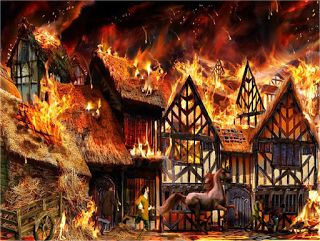 1666 The Great Fire of London began in a bakery on Pudding Lane and will destroy much of the city.
1666 The Great Fire of London began in a bakery on Pudding Lane and will destroy much of the city.

 911 Viking-monarch Oleg of Kiev-Russia signed a treaty with Byzantines. 1
911 Viking-monarch Oleg of Kiev-Russia signed a treaty with Byzantines. 1 192 Sultan Saladin and King Richard the lion hearted signed a cease fire.
192 Sultan Saladin and King Richard the lion hearted signed a cease fire.  1537 Danish King Christian III published an Ordinance on the Danish Church which ordered Denmark to convert to Lutheranism and as Norway was then ruled by Denmark, the Norwegians converted as well.
1537 Danish King Christian III published an Ordinance on the Danish Church which ordered Denmark to convert to Lutheranism and as Norway was then ruled by Denmark, the Norwegians converted as well.  1666 The Great Fire of London began in a bakery on Pudding Lane and will destroy much of the city.
1666 The Great Fire of London began in a bakery on Pudding Lane and will destroy much of the city.

Published on September 02, 2014 04:31
Available on iTunes - The Briton and the Dane by Mary Ann Bernal, narrated by Sebastian Lockwood

Written by: Mary Ann Bernal Narrated by: Sebastian Lockwood Length: 11 hrs and 30 mins Unabridged Audiobook King Alfred the Great has thwarted the Viking threat against his kingdom of Wessex. Signing a treaty with the formidable Danish King Guthrum, he succeeds in pushing the heathen army back to the rolling fens of East Anglia.
An uneasy peace holds sway: The King establishes a standing army under Lord Richard, who takes command of the citadel at Wareham.
Richard and his army are accompanied by his daughter, Gwyneth, an impetuous and reckless young woman - at once striking, intellectually gifted, but dangerously vain and imprudent.
While Richard broods on the Viking threat, Gwyneth falls in love with an enemy prince - only to discover that she has been betrothed to a Saxon warrior twice her age.
Refusing to countenance her grim fate, she flees the fortress, but is soon kidnapped by a Viking warrior and taken to the camp of King Guthrum while Saxon search parties scour the land.
In captivity, a hostage to fortune, and the focus of political intrigue, Gwyneth is submerged in a world of expediency, betrayal, and black treachery. Slowly, she realizes the truth is suspect, nothing is what it appears and her reality cannot be trusted.
And all the time, against this background, she desires nothing more than to be reunited with her dashing Danish prince.
iTunes Purchase Link

Published on September 02, 2014 04:31
September 1, 2014
Stonehenge: ghostly outlines of missing stones appear
 By Sarah Knapton,
By Sarah Knapton,Archaeologists can now say for certain that Stonehenge was once a complete circle after the dry weather revealed the ghostly outlines of missing stones
It is a mystery which has intrigued archaeologists for centuries: did the huge Neolithic stones which make up Stonehenge form a complete circle?
Now the puzzle has been answered after the dry summer revealed the faint outline of the missing megaliths. Usually the ground is watered by stewards, to keep the earth moist and the grass healthy. But this year, the hose they used was too short to reach the whole site. By chance, the incomplete section of the inner stone circle was left to dry out. When archaeological features have been buried in the ground for a long time, they affect the rate that grass grows above them, even long after they have disappeared.
In the past heatwaves have picked out the eerie outlines of Roman forts, Iron age earthworks and the remains of stone age monuments.
English Heritage said the find was ‘really significant’ and said if they had bought a longer hosepipe, the marks may never have been spotted.
"A lot of people assume we've excavated the entire site and everything we're ever going to know about the monument is known,” said Susan Greaney, from English Heritage.
"But actually there's quite a lot we still don't know and there's quite a lot that can be discovered just through non-excavation methods.
"It's great that people who know the site really well and look at it every day were able to spot these parch marks and recognise them for what they were.
"We maintain the grass with watering when it's very dry in the summer, but our hosepipe doesn't reach to the other side of the stone circle. If we'd had a longer hosepipe we might not have been able to see them.
“It's really significant, and it shows us just how much we still have to learn about Stonehenge.”
Historians have long wondered whether Stonehenge was an intentionally-incomplete circle, but countless high resolution geophysical surveys and excavations have failed to give the answer.
Staff only water the site during the driest weeks of summer, but the hosepipe doesn't reach to the south-west quadrant where there is a gap in the circle.
Worker Tim Daw spotted the patches on the ground - now thought to be 'stone holes' - where the grass was more parched.
He said: "I was standing on the public path looking at the grass near the stones and thinking that we needed to find a longer hosepipe to get the parched patches to green up.
"A sudden light-bulb moment in my head, and I remembered that the marks were where archaeologists had looked without success for signs that there had been stone holes, and that parch marks can signify them.
"I called my colleague over and he saw them and realised their possible significance as well. Not being archaeologists we called in the professionals to evaluate them.
"I am still amazed and very pleased that simply really looking at something, that tens of thousands of people had unwittingly seen, can reveal secrets that sophisticated machinery can't."
http://www.telegraph.co.uk/earth/environment/archaeology/11066703/Stonehenge-ghostly-outlines-of-missing-stones-appear.html

Published on September 01, 2014 07:50
The Briton and the Dane featured on Bargain Books
Ereader News feature:
http://ereadernewstoday.com/more-kindle-deals-for-9-1-14/6747700/
 King Alfred the Great has thwarted the Viking threat against his kingdom of Wessex. Signing a treaty with the formidable Danish King Guthrum, he succeeds in pushing the heathen army back to the rolling fens of East Anglia.
King Alfred the Great has thwarted the Viking threat against his kingdom of Wessex. Signing a treaty with the formidable Danish King Guthrum, he succeeds in pushing the heathen army back to the rolling fens of East Anglia.
An uneasy peace holds sway: The King establishes a standing army under Lord Richard, who takes command of the citadel at Wareham.
Richard and his army are accompanied by his daughter, Gwyneth, an impetuous and reckless young woman – at once striking, intellectually gifted, but dangerously vain and imprudent.
While Richard broods on the Viking threat, Gwyneth falls in love with an enemy prince - only to discover that she has been betrothed to a Saxon warrior twice her age.
Refusing to countenance her grim fate, she flees the fortress, but is soon kidnapped by a Viking warrior and taken to the camp of King Guthrum while Saxon search parties scour the land.
In captivity, a hostage to fortune, and the focus of political intrigue, Gwyneth is submerged in a world of expediency, betrayal and black treachery. Slowly, she realizes the truth is suspect, nothing is what it appears and her reality cannot be trusted.
And all the time, against this background, she desires nothing more than to be reunited with her dashing Danish prince.
http://ereadernewstoday.com/more-kindle-deals-for-9-1-14/6747700/
 King Alfred the Great has thwarted the Viking threat against his kingdom of Wessex. Signing a treaty with the formidable Danish King Guthrum, he succeeds in pushing the heathen army back to the rolling fens of East Anglia.
King Alfred the Great has thwarted the Viking threat against his kingdom of Wessex. Signing a treaty with the formidable Danish King Guthrum, he succeeds in pushing the heathen army back to the rolling fens of East Anglia. An uneasy peace holds sway: The King establishes a standing army under Lord Richard, who takes command of the citadel at Wareham.
Richard and his army are accompanied by his daughter, Gwyneth, an impetuous and reckless young woman – at once striking, intellectually gifted, but dangerously vain and imprudent.
While Richard broods on the Viking threat, Gwyneth falls in love with an enemy prince - only to discover that she has been betrothed to a Saxon warrior twice her age.
Refusing to countenance her grim fate, she flees the fortress, but is soon kidnapped by a Viking warrior and taken to the camp of King Guthrum while Saxon search parties scour the land.
In captivity, a hostage to fortune, and the focus of political intrigue, Gwyneth is submerged in a world of expediency, betrayal and black treachery. Slowly, she realizes the truth is suspect, nothing is what it appears and her reality cannot be trusted.
And all the time, against this background, she desires nothing more than to be reunited with her dashing Danish prince.

Published on September 01, 2014 05:57




